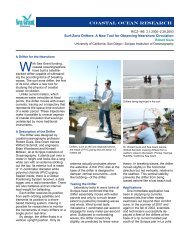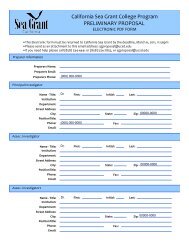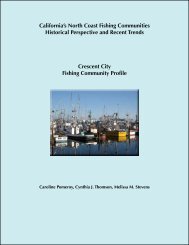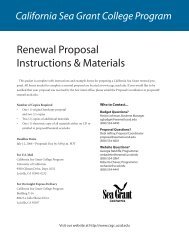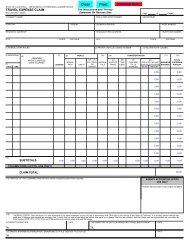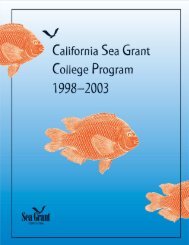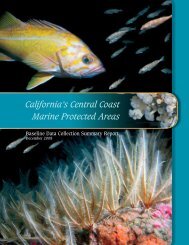2001â2002 - California Sea Grant - UC San Diego
2001â2002 - California Sea Grant - UC San Diego
2001â2002 - California Sea Grant - UC San Diego
You also want an ePaper? Increase the reach of your titles
YUMPU automatically turns print PDFs into web optimized ePapers that Google loves.
ecause it is older individuals that have the greatest likelihood of acquiring<br />
parasites.<br />
All crab specimens were dissected, and their muscle tissue, gills and<br />
digestive glands were then microscopically examined for encysted larvae of<br />
lung flukes. None of the crabs were found to harbor evidence of lung<br />
flukes, either Asian or North American. More than 400 adult crayfish were<br />
similarly examined with the same<br />
result. None of the crustaceans<br />
showed any signs of fluke infestation.<br />
This finding is considered statistically<br />
significant, not an artifact of a<br />
small sample size, because of the<br />
high rate of infection in endemic<br />
regions. In an infected waterway, 20<br />
to 80 percent of adult mitten crabs<br />
would be expected to harbor flukes.<br />
Even commercially sold mitten crabs<br />
can have high rates of infection. In one random sample of 85 mitten crabs<br />
from markets in Seoul, Korea, for instance, about 12 percent carried<br />
flukes. Because absolutely no trace of fluke parasitism was found in the<br />
Bay–Delta<br />
crustaceans, the<br />
scientists<br />
believe that the<br />
chance of<br />
getting a fluke<br />
infection from<br />
a mitten crab<br />
is, at present,<br />
negligible.<br />
“The Centers for Disease Control told health<br />
officials that <strong>California</strong> should assume that the<br />
lung fluke could be present at any time because<br />
the risk is present at all times.”<br />
—SUSAN WEBB, chair of the multi-agency Mitten<br />
Crab Management Control Committee<br />
In terms of future risk, however, the news was not as good. The researchers’<br />
survey of snail populations showed that in every major geographical<br />
region of the Bay–Delta, there is at least one abundant snail<br />
species that could serve as a fluke host. These species, they showed, are<br />
also eaten by crabs and crayfish, meaning that trophic transmission of<br />
flukes is possible. Their conclusion: a future outbreak is possible. All<br />
requisite hosts are present in sufficient<br />
abundance and distribution for transmission<br />
and spread of a fluke infestation.<br />
How would such an infestation come<br />
about? Flukes could be introduced through<br />
ballast water discharges of infected eggs,<br />
through infected juvenile snails or infected<br />
juvenile mitten crabs, or through the importation<br />
of infected feral or domestic mammals:<br />
dogs, cats, foxes, raccoons or possums. It is<br />
also possible that infected people, who<br />
excrete fluke eggs in their feces, could<br />
introduce or spread flukes, the scientists reported.<br />
The scientists recommended monitoring parasitism in mitten crabs in<br />
the Bay–Delta and developing a risk-assessment model based on the size<br />
of the mitten<br />
crab population<br />
and on infection<br />
rates of people<br />
living in the Bay<br />
area.<br />
Mitten crabs are a delicacy in Asia. Photo: Johnson Wang of the<br />
<strong>California</strong> Department of Water Resources<br />
Hoards of mitten crabs clog a fish salvage system, requiring<br />
workers to drain the tank. Photo: U.S. Bureau of Reclamation<br />
11



